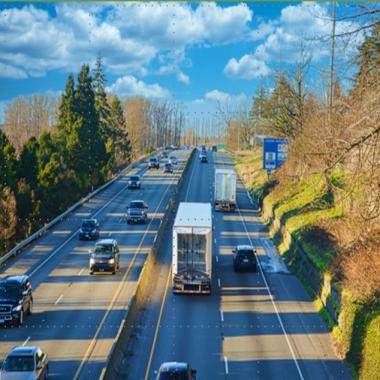The I-5 Skagit Transportation Study (STS) Phase I report: I-5 Skagit Transportation Study Appendices (PDF 4.3MB)
Background
Interstate 5 is the primary north-south transportation corridor in Skagit County and is part of the National Highway System. The study area is in the urban areas of Mount Vernon and Burlington between the Old Highway 99 interchange at exit 223 and the Cook Road Interchange at exit 233. The study area is about 9 miles. The estimated population in the urban area was about 49,500 in 2019-2020 according to the Washington State Office of Financial Management.
I-5 is a four-lane divided interstate and consists primarily of 12-foot driving lanes and an 8-foot shoulder. The posted speed limit varies between 60 miles per hour and 70 miles per hour within the study area. The urban area posted speed limit is 60 miles per hour. There are eight interchanges within the corridor with a total of 30 ramps that provide access on and off the interstate to regional and local destinations. All interchanges are separated by one or more miles. Four interchanges carry traffic to four other state highway routes east and west of I-5. These routes include State Routes 536, 538, 20 and 11.
The Skagit River is a major barrier to access between the two communities of Mount Vernon and Burlington. There are only two north-south bridges across the Skagit River, the I-5 Skagit River Bridge (now formally known as the I-5 Trooper Sean M. O’Connell Jr. Memorial Bridge) and a local bridge known as the Riverside Bridge. The Riverside Bridge is parallel to I-5 and serves as the primary local corridor connecting the commercial areas between the communities of Burlington to the north and Mount Vernon to the south. The Riverside Bridge accommodates all modes of transportation including bicycles, pedestrians and transit.
Bicycles are permitted on a portion of the interstate in Burlington and Mount Vernon but are restricted across the I-5 Skagit River Bridge between the College Way Interchange exit 227 in Mount Vernon and George Hopper Road Interchange at exit 229 in Burlington. Additionally, many local streets in the urban area permit pedestrians, bicycles and other rollers. Skagit Transit is the primary service provider for transit services in Skagit County.
Existing Conditions Assessment
The initial study was conducted in 2021, and included collecting and analyzing existing traffic operations and safety data to determine if I-5 in the Mount Vernon-Burlington urban area met expectations for multimodal transportation in Washington State.
I-5 Skagit Transportation Study (STS)
Started in 2023, this Phase of the study is the current study under public review. The effort analyzes existing and future conditions on the I-5 Corridor to determine future needs of the I-5 corridor in the Mount Vernon-Burlington urban areas. The study included an assessment of social economic demographics, community surveys, environmental assessment, and a transportation operations and safety analysis. The findings from the study will be used to identify strategy solutions and investment considerations for the efficient movement of people and goods.
February 2023 - June 2023
Forecasting, demographic analysis and problem and needs identification
March 2023 - July 2024
Public engagement
July 2023 - July 2024
Solution alternatives identification, analysis and feasibility
The I-5 Skagit Transportation Study is funded through state appropriations.

